Do you know about the Koto Ward in Tokyo? It is one of the 23 wards of Tokyo, encompassing a variety of unique neighborhoods and areas with different things to do and sights to see. With its diverse cultural and historical attractions, Koto Ward offers a range of experiences for visitors to enjoy. From traditional temples and shrines to modern entertainment and shopping districts, there’s something for everyone in Koto Ward.
If you are wondering about Koto Ward, you’ll find a wealth of information in this ultimate guide. Koto Ward is known for its distinct neighborhoods, each offering its own unique charm and attractions. Whether you’re interested in delving into the area’s rich history, exploring top sights, or finding the best accommodation options, this comprehensive guide has got you covered. Discover the best things to do and see in Koto Ward, and gain valuable insights into the area’s cultural and historical significance.
A Quick Primer to Koto Ward
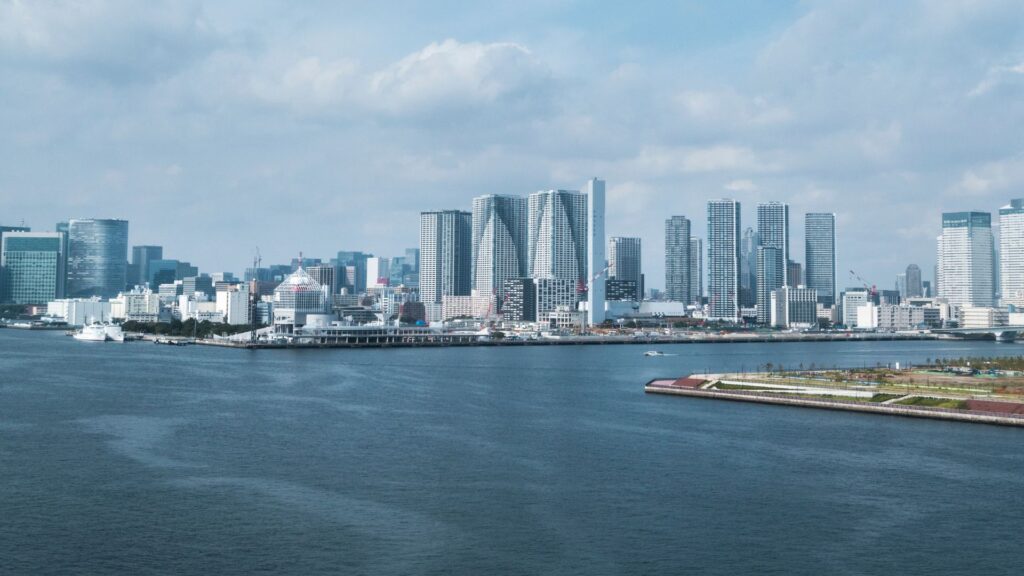
Koto Ward stretches across the Sumida River in the eastern part of Tokyo. Nowadays, the area has become a chic and trendy destination, featuring the Tokyo waterfront sub-centre, the tower condominiums in Toyosu and Shinonome, and Kiyosumi Shirakawa, a gathering place for coffee-loving individuals.
There was a time when garbage from all over Tokyo was collected on Yumenoshima in Koto Ward, and the whole town was covered with flies. There are still many neighbourhoods with a dark history, such as Shiomi, where former residents of the Bataya tribe moved to, Edagawa 1-chome, home to zainichi Koreans, and Toyo 1-chome, the site of Suzaki, one of the biggest brothels along with Yoshiwara.
On the other hand, Monzennakacho and Kiyosumi-Shirakawa, which are located near the Sumida River in Koto Ward, are within easy reach of Ginza and Tokyo Station by bicycle. The rent prices in these areas are also “soaring” due to the popularity of Koto Ward. In addition, Toyosu and Shinonome, which feature many tower blocks, are regularly ranked among the top “desirable places to live”.
The Tokyo Big Sight in Ariake, the sacred site of Comiket where otaku gather in droves, and Aomi in the Odaiba area are also spots in Koto Ward.
On the other hand, Kameido, located at the northernmost tip of the district along the Sobu Line, and Oshima, a town full of apartment complexes to the south of Kameido, are also located in Koto Ward. These areas are more chaotic, with a large number of low-income and Chinese residents. Sunamachi Ginza, the inexpensive kitchen of the common people that is far from the station but still thrives, is also alive and well. Koto Ward is, after all, a bustling downtown area.
Living in Koto Ward
Koto Ward was originally a “downtown” area, and Fukagawa, in particular, has its roots in a rickety fisherman’s town. The food in the area was equivalent to Yoshinoya’s beef bowl, serving as the fishermen’s bribe food.
The new fashionable class and celebrities are moving into Monzennakacho, Kiyosumi-Shirakawa, and Toyosu in the western part of Koto Ward, changing the atmosphere of the city. The Toei Shinjuku Line, which has a modest image, is also home to many old-fashioned business hotels. The game corner of Daiei is full of elderly residents from the housing complexes.
Kameido on the Sobu Line also remains a lower-class town, as evidenced by the presence of Sankei Supermarket, which proudly sells very cheap 200-yen bento boxes and expired foods. No matter how many beautiful and chic townhouses are built in Koto Ward, this is what it means to live in Koto Ward. Before paying high housing costs to start living in Koto Ward, please keep this in mind.
History of Koto Ward
The development of Koto Ward was triggered by land reclamation that began in the early Edo period. Around 1600, Fukagawa Hachiroemon developed new rice fields around Morishita and founded Fukagawa Village. When a large fire broke out in 1657, the shogunate began building a fire-resistant town.
In 1659, Sunamura Shinzaemon and his family developed the area around Horokushima and named it Sunamura Shinden. Efforts were made to redevelop and expand the city area. The Fukagawa district, with rivers running in all directions, developed as a wholesale district for warehousing, lumber, rice, oil, and other commodities, and the culture of the common people permeated the area.
The Joto area, on the other hand, flourished as agricultural land and became a popular vacation spot. In the Meiji period, the area developed into an industrial hub, taking advantage of the vast land and water transportation.
Although the area was severely damaged in the Great Kanto Earthquake, large-scale rezoning was carried out and the area was gradually rebuilt. Most of the existing bridges were constructed during this time.
In 1947, Fukagawa and Joto wards merged to form Koto Ward, named after its location east of the Sumida River. Postwar reconstruction was remarkable, and a rush to build metropolitan housing continued. Although the area was vulnerable to flooding, extensive construction of levees and other infrastructure, as well as the construction of subways and the Metropolitan Expressway, improved both safety and convenience.
Areas of Koto Ward
Along the Subway Tozai Line
Monzennakacho 門前仲町
This town is in front of the well-known Fukagawa Fudo and Tomioka Hachiman Shrine. It is positioned as the cultural centre of “Fukagawa” in Koto Ward, and land prices are extremely high, partly because it is next to Kayabacho station and served by the Oedo subway line. However, a short distance from the station, the “Oharu” Chinese noodle shop with a three-coloured flag barracks stands tall and appeals to the Showa-era downtown atmosphere.
Kiba 木場

This was the lumberyard area before Shinkiba. The area surrounding Kiba Park, an oasis for Koto Ward residents, has been encroached upon by the chalet power of Kiyosumi Shirakawa, where conscious people gather, and is now popular among new residents who mistakenly think Fukagawa is a fashionable town.
Toyocho 東陽町

Home to the Koto Ward Office and the Driver’s License Examination Centre, Toyocho developed as an office district to alleviate congestion on the Tozai Line, which is well-known for its hellish commute. However, the population along the line has increased too much, causing it to become a burnt hole.
Toyo 1-chome is the site of the Suzaki Amusement Centre, the second largest after Yoshiwara. The café buildings of the postwar Suzaki Paradise on the red line were also completely destroyed.
Minamisunamachi 南砂町

The southern end of Sunamachi is said to be the worst neighbourhood in Koto Ward. In front of the station, there are only warehouses, apartment complexes, condominiums, and Sunamo. Sunamachi Ginza Shopping District, the kitchen of downtown, is famous, but it is a 20-minute walk from the station, which is quite far. The area looks like a suburb with many roadside stores and shopping malls.
Along the Subway Hanzomon Line
Kiyosumi-Shirakawa 清澄白河

A town of temples and graveyards that has been transformed into a coffee town for the conscious and fashion-conscious due to the direct connection from Shibuya to Kiyosumi-Shirakawa by the Hanzomon Line.
The organic café eateries that have proliferated like bamboo shoots after the rain in recent years offer the usual West Coast delicacies. Blue Bottle Coffee, Kiyosumi Garden, and the Museum of Contemporary Art Tokyo are among their favourites.
Sumiyoshi 住吉
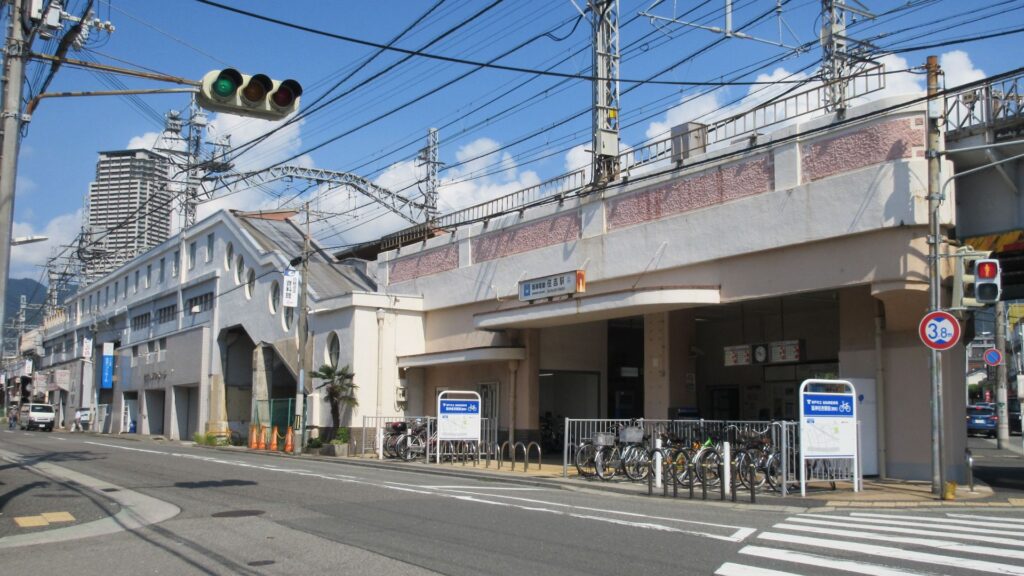
Famous for Sarue Onshi Park and Tomomi Hanahara’s mother’s company, Sumiyoshi retains its Showa-era charm. Ogibashi, across the Onagi River, is a shopping district that has been left behind by the city’s development.
Along the Toei Shinjuku Line
Morishita 森下

A place associated with Suiwa Tagawa of “Norakuro”, known only to the Showa generation. Passing through the Takahashi Rakurod shopping street, which has been left behind by the times, you will find an area that used to be the second largest entertainment district after Yamaya. The area is dotted with simple lodging houses and old-fashioned business hotels.
Nishi Oshima 西大島

The western end of Oshima, a huge housing complex town. Oshima 4-chome Danchi and the Daiei Oshima store are home to many elderly people living in the complex. They spend their free time playing pachinko on the pachinko machines in the game corner.
Oshima 大島

The Oshima 6-chome housing complex is huge for the prime location in front of the station. In recent years, an Indian community has formed here, turning it into Koto Ward’s Little Delhi. There are two shopping streets with a downtown atmosphere: Oshima Chuo Ginza and Sunroad Nakanobashi.
Higashi Oshima 東大島
The station platform straddles the old Nakagawa River. The right half is Komatsugawa, Edogawa Ward. The area around the station is mostly made up of apartment complexes, condominiums, and Oshima Komatsugawa Park. The shopping centre is the Daiei Higashi-Oshima store.
Along the JR Sobu Line and Tobu Kameido Line
Kameido 亀戸

The only town in Koto Ward along the Sobu Line. The alleyway at the north exit is filled with the smell of meat and fat. The number of Chinese residents is exploding along Kameido Chuo-dori Street beyond the alley. The 200 yen bento lunches, Sankei Supermarket, and a wide variety of very inexpensive stores make this a great place for affordable shopping.
Kameido Suijin 亀戸水神

A lot of elderly people come here on the Tobu Kameido Line, mistaking it for Kameido Tenjin. In front of the station is Kameido Chuo Park and a cluster of rundown apartments. Toei residential houses are all over the area.
Along the JR Keiyo Line
Etchujima越中島

A very minor station with the fewest number of passengers in the JR Tokyo metropolitan area. Even during commuting hours, the station platform is sparsely populated. The area around the station is almost entirely occupied by the Tokyo University of Marine Science and Technology campus. Tsukishima and Monzennakacho stations are only a 10-minute walk away.
Shiomi 潮見
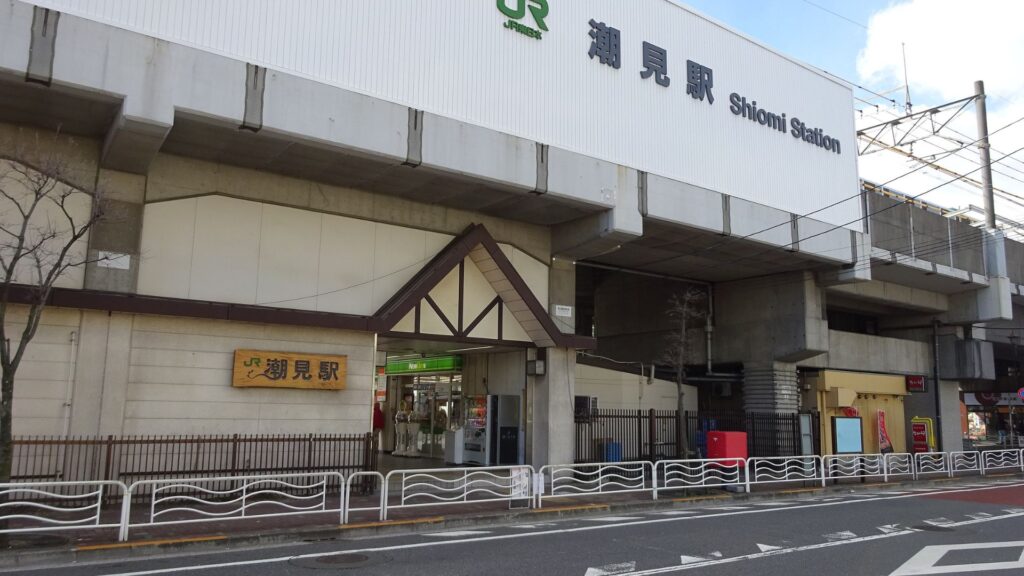
The area around the station is a remote island surrounded by canals. There used to be an area that was created by people of the lower class who lived along the Sumida River. A witness to this history is the Catholic Shiomi Church, and the apartment building where a murder took place in 2008 still stands.
Shinkiba 新木場
The sprawling Yumenoshima Park and complex were built on an artificial garbage island that was the site of the Tokyo Garbage War during the high-growth period. The area around the station has no permanent population, as it is exclusively occupied by transit passengers.
Along the Subway Yurakucho Line
Toyosu 豊洲

What used to be a town of factories and warehouses has been transformed into a Tokyo bayside town where pseudo-celebrities live, and the number of wealthy Chinese residents is on the rise.
Tatsumi 辰巳

A special zone created by building many metropolitan apartment complexes on an isolated island. The housing complexes are in a state of severe deterioration and ageing, and are in a state of ubasan (old woman’s dungeon). The shopping streets attached to the housing complexes are also retro. This place is in contrast to Shinonome, which is lined with tower blocks across a canal.
Along the Rinkai Line and Yurikamome Line
Shinonome 東雲
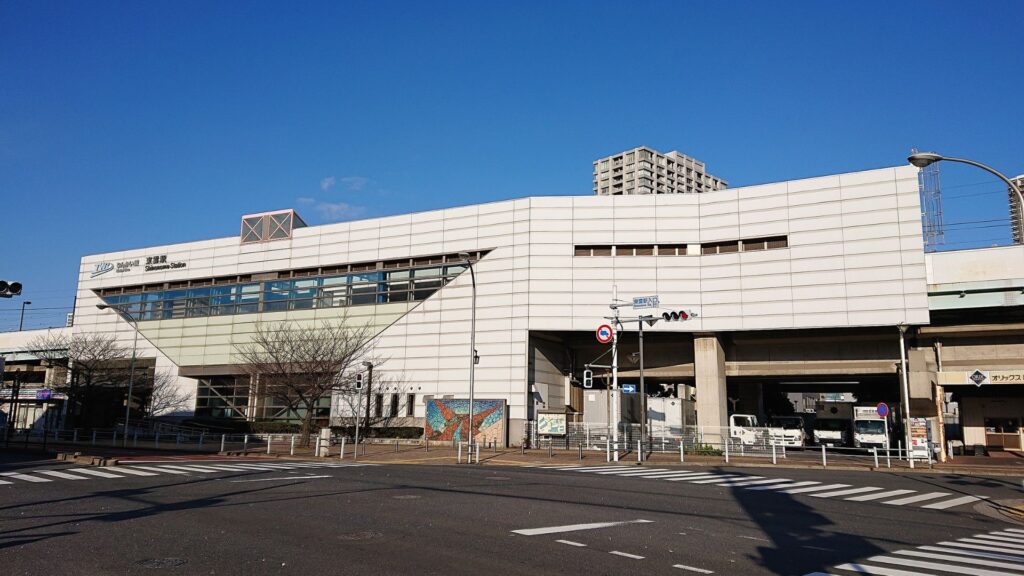
Toyosu’s tower block bubble has spread to Shinonome across the canal. The area around the Aeon Shinonome store is occupied by tower blocks and designer housing complexes, while the rest of Shinonome is an empty warehouse district. Fukushima earthquake victims have moved into public employee housing here.
Ariake 有明
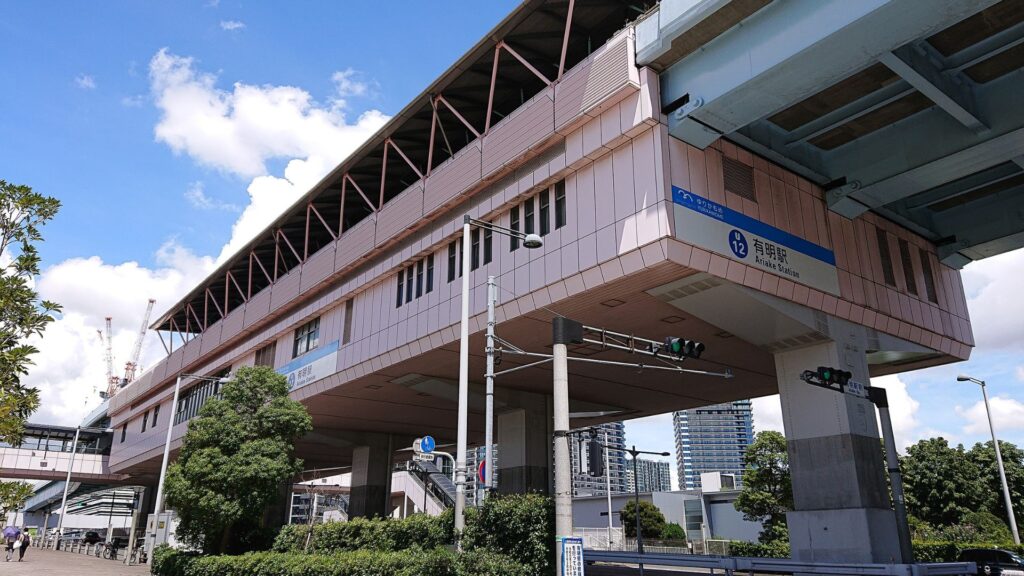
Ariake is home to Tokyo Big Sight, the sacred site of the Comic Market where otaku from all over the world gather. It is hard to believe that a townhouse has been built in such an unlivable place and has a permanent population.
Aomi 青海

Aomi in Koto Ward is the southern half of landfill site No. 13, known as Odaiba. Tokyo Teleport Station, Diver City, and the National Museum of Emerging Science and Innovation are located here. A large number of foreign students and researchers have settled in Tokyo International Exchange Centre, and Aomi 2-chome has the largest percentage of foreign residents among the 23 wards.
Shin-Toyosu・ Shijō-mae 新豊洲・市場前

Yurikamome Ichiba-mae Station is located in the area where the new Toyosu market is scheduled to be built, where the relocation plan has been stalled for many years due to soil contamination problems. For a long time, it was the most powerful “unexplored station in the city” with nothing in front of it.
What to Do in Koto Ward
Tomioka Hachimangu 富岡八幡宮

Tomioka Hachimangu Shrine in Koto Ward is the largest Hachiman Shrine in Edo and has continued to attract the faith of many people, from commoners to the Tokugawa shoguns, to the present day. The shrine, long known as “Fukagawa no Hachiman-sama” (the Hachiman of Fukagawa), attracts many worshippers for its numerous merits, such as prayers for victory, healing of illness, improvement of financial fortune, better luck, and matchmaking.
The regular festival of Tomioka Hachiman Shrine, called the “Fukagawa Hachiman Festival,” is one of the “Three Great Festivals of Edo,” along with the Sanno Festival of Hie Shrine in Akasaka and the Kanda Festival of Kanda Myojin. The main festival, held once every three years, features more than 120 portable shrines, both large and small, with the procession of the large portable shrines being a heroic event. Known as the “Mizukake Matsuri,” spectators splash purifying water on the mikoshi bearers, creating a dynamic spectacle.
One of the many highlights of Tomioka Hachimangu Shrine is the gorgeous golden mikoshi, said to be the largest in Japan, standing 4.4 metres high and weighing 4.5 tonnes, adorned with pure gold and jewels. The phoenix at the top and the diamond eyes of the guardian dog are particularly striking. Visitors can view the mikoshi from 9:00 a.m. to 5:00 p.m., and until 8:00 p.m. on the day of the Tsukiji Festival. Tomioka Hachimangu Shrine is also known as the birthplace of Edo Kanjin Sumo, with a monument to yokozuna wrestlers on its grounds.
Find out more about Tomioka Hachimangu here on Google maps.
Statue of Ino Tadataka 伊能忠敬像

Ino Tadataka, a surveyor from the late Edo period known for creating the first map of Japan, settled in Kuroe-cho (now Monzennakacho 1-chome) near Tomioka Hachiman Shrine at the age of 50. He frequently visited Tomioka Hachimangu Shrine before departing on his surveying trips, which he started about 200 years ago in 1800. Over 16 years, he organised a total of 10 trips, always leading his uchi-deshi and followers to pray for their safety at Tomioka Hachimangu Shrine before surveying Senju, Shinagawa-juku, and other locations.
In addition to Tadataka’s residence, the Fukagawa area is home to the site of the calendar bureau where he studied astronomy, the road where he trained in pacing, and the place where he ended his life. These sites reflect the deep connection between Tadataka’s surveying and Koto Ward.
Find out more about Statue of Ino Tadataka here on Google maps.
Kiyosumi Gardens 清澄庭園
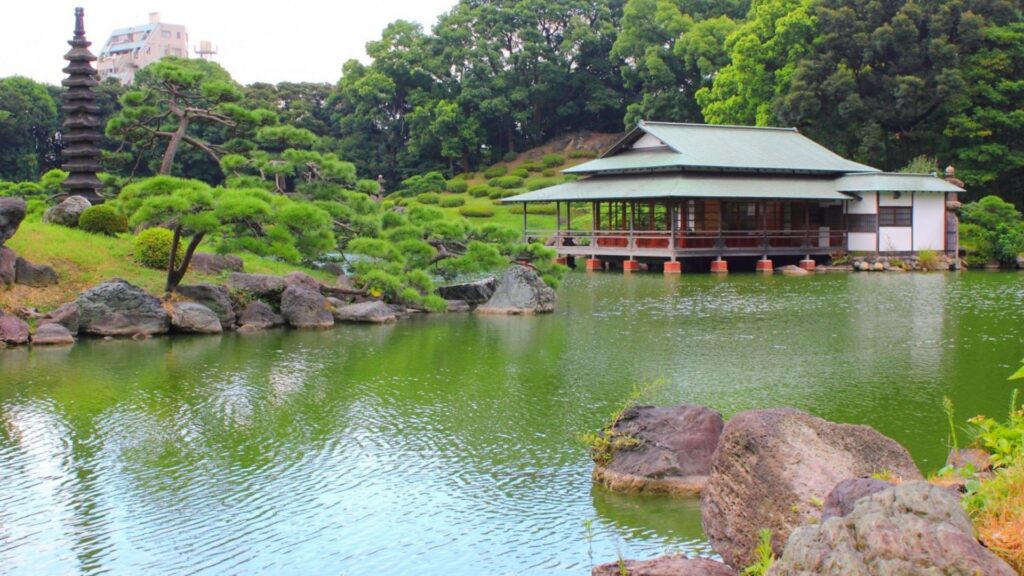
Located in Kiyosumi, Koto Ward, Kiyosumi Gardens is a circular garden featuring a large pond, an artificial hill, and a dry landscape. This gardening technique, used in the Edo period for feudal lords’ gardens, was modernised and perfected in the Meiji period at Kiyosumi Garden. The garden boasts historical buildings such as Taisho Memorial Hall and Ryotei Pavilion, as well as a rich variety of flora and fauna.
A highlight is the large pond with three central islands, called Sensui. The pond’s reflections of islands, sukiya-style buildings, and trees create a picturesque scene. Visitors can enjoy various views while walking along the garden path. The Ryotei Pavilion, designated as a “Tokyo Selected Historical Building,” is a sukiya-style structure jutting into the pond, enhancing the garden’s Japanese atmosphere. Built by the Iwasaki family in 1909, the Ryotei Pavilion welcomed British General Kitchener as a state guest.
Find out more about Kiyosumi Gardens here on Google maps.
National Museum of Emerging Science and Innovation 日本科学未来館

The National Museum of Emerging Science and Innovation, one of Koto Ward’s most popular tourist spots, is located in Odaiba. Despite its initially intimidating name, the museum is full of interactive innovations that appeal to children and adults alike. On the first floor, the “Geo-Cosmos,” a giant earth display approximately 6 metres in diameter, uses over 10,000 OLED panels to create a realistic image of the earth shining in space with a resolution of more than 10 million pixels.
The third-floor zone, themed “Creating the Future,” features state-of-the-art robot exhibits, allowing visitors to interact with robots and contemplate the future of life enhanced by robotics. The fifth-floor “Explore the World” zone is ideal for those interested in space, the global environment, and life, featuring exhibits such as “This is the International Space Station,” a reproduction of the ISS’s interior.
Find out more about National Museum of Emerging Science and Innovation here on Google maps.
Etchujima Park 越中島公園
Located downstream from the Eitai Bridge over the Sumida River, Etchujima Park in Koto Ward is a popular spot for sightseeing with a beautiful night view. Often used as a location for TV dramas and commercials, the park features a 500-metre-long walking path facing the Sumida River, with views of high-rise condominium towers, the Chuo Ohashi Bridge, Tokyo Tower, and Eitai Bridge. This makes it an excellent location for various activities.
Etchujima Park, along with nearby Aioi Bridge and Ishikawajima Park, is popular for dog walking, jogging, and other outdoor activities. The well-maintained walking paths attract many running enthusiasts. Free rental bicycles are available, making cycling a great way to enjoy the park. The night view, with illuminated bridges and reflected lights on the water, creates a fantastic sight, making it a great date spot.
Find out more about Etchujima Park here on Google maps.
Kameido Tenjin Shrine 亀戸天神社

Kameido Tenjin, whose deity is Sugawara no Michizane, is a recommended sightseeing spot in Koto Ward for those seeking contemplation. Built in 1646, the shrine features a traditional torii gate, a drum bridge, and a pond with fish and turtles. The Sky Tree towers to the left of the shrine, blending old history with the future.
The shrine is beautiful year-round, with plum blossoms and wisteria in spring and chrysanthemums in autumn. The wisteria festival from late April to early May is particularly stunning, with wisteria flowers in full bloom. During the festival, the wisteria is illuminated from sunset to midnight. The walk from Kameido Station to Kameido Tenjin Shrine offers a chance to explore the downtown area, famous for its kuzumochi (kuzu mochi).
Find out more about Kameido Tenjin Shrine here on Google maps.
Tokyo Big Sight 東京ビッグサイ

Tokyo Big Sight opened in 1996 as a comprehensive convention facility, featuring one of Japan’s largest exhibition halls, an international conference hall with a capacity of 1,000 people, and a reception hall. Recently, the number of visitors has exceeded 10 million annually, with various events held throughout the year, many of which are free of charge.
In addition to well-known comic markets and motor shows, Tokyo Big Sight is frequently used for large gatherings, such as joint information sessions for job hunting. The building’s impressive exterior, resembling an objet d’art, stands out along the Tokyo Bay shore. With a wide variety of stores and restaurants, visitors are advised to allow plenty of time during events due to expected crowds.
Find out more about Tokyo Big Sight here on Google maps.
Museum of Contemporary Art Tokyo
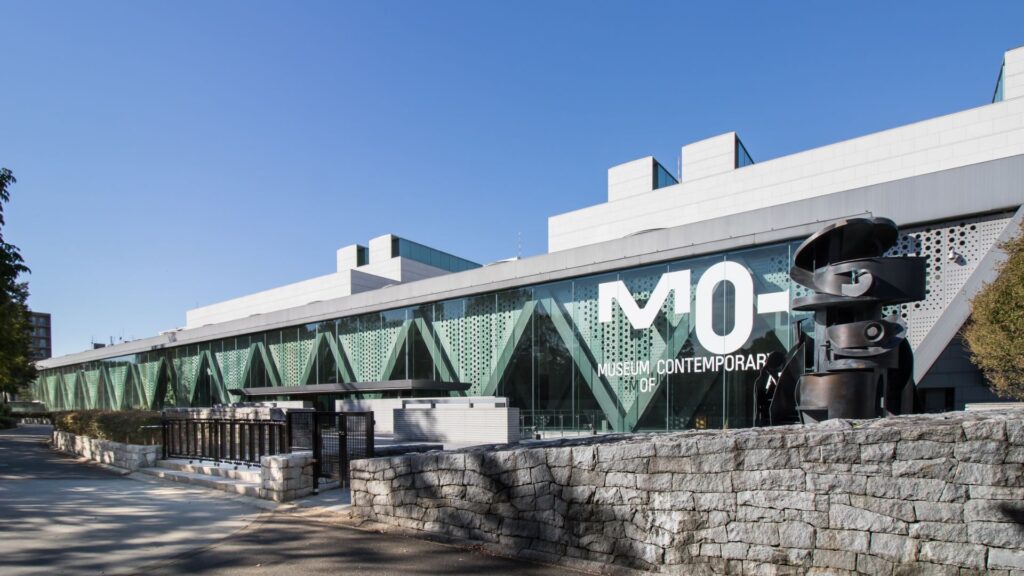
The Museum of Contemporary Art Tokyo opened in March 1995 to promote contemporary art and enhance the foundation of art and culture. Utilising its collection of approximately 5,200 works, the museum holds exhibitions of contemporary art, including collection exhibitions that introduce the history of art in Japan and abroad, and distinctive special exhibitions, such as large-scale international exhibitions. Visitors can experience a wide range of art, including paintings, sculpture, fashion, architecture, and design.
The museum also has an art library with approximately 100,000 art-related books and conducts activities to promote art, such as workshops, various lectures, and lectures aimed at spreading art education.
Find out more about Museum of Contemporary Art Tokyo here on Google maps.
Tokyo Gate Bridge 東京ゲートブリッジ

Opened in February 2012, Tokyo Gate Bridge is a 2,618-metre bridge crossing the Wakasu district of Edogawa Ward and the reclaimed Tokyo Tokaiji. It is a new landmark of Tokyo Bay, with a distinctive design resembling dinosaurs facing each other, earning it the nickname “Dinosaur Bridge.” This bridge is a popular spot among night view lovers.
Rising 87.8 metres above sea level, visitors can walk up the walkway from Wakasu Seaside Park and enjoy a panoramic view of Tokyo Port. At night, the bridge is illuminated with simple yet beautiful blue and white lighting. The Tokyo Gate Bridge offers spectacular views during the day, a beautiful sunset, and illuminated lights at night, making it a fantastic date location.
Find out more about Tokyo Gate Bridge here on Google maps.
Events in Koto Ward
Kameido Tenjin Wisteria Festival 亀戸天神藤まつり
When: Late April to Early May
The Kameido Tenjin Wisteria Festival, held annually, is a celebrated event in Koto Ward. The festival takes place at Kameido Tenjin Shrine, renowned for its beautiful wisteria flowers in full bloom during this period. Visitors can enjoy the sight of wisteria trellises draped with cascading flowers that create a stunning canopy of purple and white blossoms.
The wisteria flowers are illuminated from sunset to midnight, creating a magical atmosphere. The festival also features various cultural performances, traditional music, and food stalls offering local delicacies. It is an excellent opportunity for photography, with the wisteria flowers providing a picturesque backdrop against the historic shrine and the modern Sky Tree visible in the distance.
Fukagawa Hachiman Festival 深川八幡祭り
When: Mid-August (Every Three Years)
The Fukagawa Hachiman Festival, held every three years in mid-August, is one of the Three Great Festivals of Edo, alongside the Sanno Festival and the Kanda Festival. The festival is hosted by Tomioka Hachimangu Shrine and attracts thousands of participants and spectators. The event is also known as the “Mizukake Matsuri” due to the unique tradition of splashing water on the mikoshi (portable shrine) bearers as they parade through the streets.
The highlight of the festival is the procession of over 120 mikoshi, including the magnificent golden mikoshi, considered the largest in Japan. Participants carry the mikoshi through the neighbourhood, accompanied by traditional music and chanting. The dynamic water-splashing ritual is not only a spectacle but also a way to purify the participants and the mikoshi.
The festival also includes various traditional performances, food stalls, and entertainment, making it a lively and exciting event for all ages.
Tomioka Hachiman Shrine Annual Festival 富岡八幡宮例大祭
When: Mid-August (Annually)
The Tomioka Hachiman Shrine Annual Festival, held every year in mid-August, is a significant cultural event in Koto Ward. The festival, also part of the Three Great Festivals of Edo, celebrates the rich history and traditions associated with Tomioka Hachimangu Shrine.
The festival features a grand procession of mikoshi, traditional music and dance performances, and various religious ceremonies. The golden mikoshi, adorned with pure gold and jewels, is one of the main attractions. The procession winds through the streets, and spectators often join in the festivities by splashing water on the mikoshi bearers, similar to the Fukagawa Hachiman Festival.
Visitors can also enjoy a variety of food stalls offering traditional Japanese snacks and local specialities, as well as games and entertainment for children. The festival atmosphere is vibrant and festive, providing a unique insight into the cultural heritage of Koto Ward.
Hotels in Koto Ward
Keisei Richmond Hotel Tokyo Monzennakacho (3 Stars)

Located in Koto Ward, Keisei Richmond Hotel Tokyo Monzennakacho is near several attractions, including Fukagawa Park (400 m), Botancho Park (400 m), and Ozeki Stone Tomioka Hachiman Monument (500 m). The hotel is close to Tomioka Hachimangu Temple, Old Nitta Bridge, and Ino Tadataka House Ruins. The nearest airport is Tokyo Haneda International Airport, 25 km away.
Hotel Trusty Tokyo Bayside (4 Stars)

This property is an 11-minute walk from the beach. Offering a massage service and a restaurant with international cuisine, Hotel Trusty Tokyo Bayside is a 7-minute walk from Tokyo Big Sight Station on the Yurikamome Line. Palette Town and Tokyo Big Sight Exhibition Centre are a 10-minute walk from the hotel, and the Fuji TV Building is a 20-minute walk away. The Ginza area and Tsukiji Fish Market are a 15-minute taxi ride.
Mitsui Garden Hotel Toyosu BAYSIDE CROSS Tokyo (4 Stars)

Mitsui Garden Hotel Toyosu BAYSIDE CROSS Tokyo offers rooms in Koto Ward, 100 m from Urban Dock LaLaport Toyosu and 500 m from the i-muse IHI History Museum. Popular points of interest near the hotel include the Construction Technology History Exhibition Room, Gas Science Museum, and Harumi Island Triton Square.
The Share Hotels Lyuro Tokyo Kiyosumi (3 Stars)
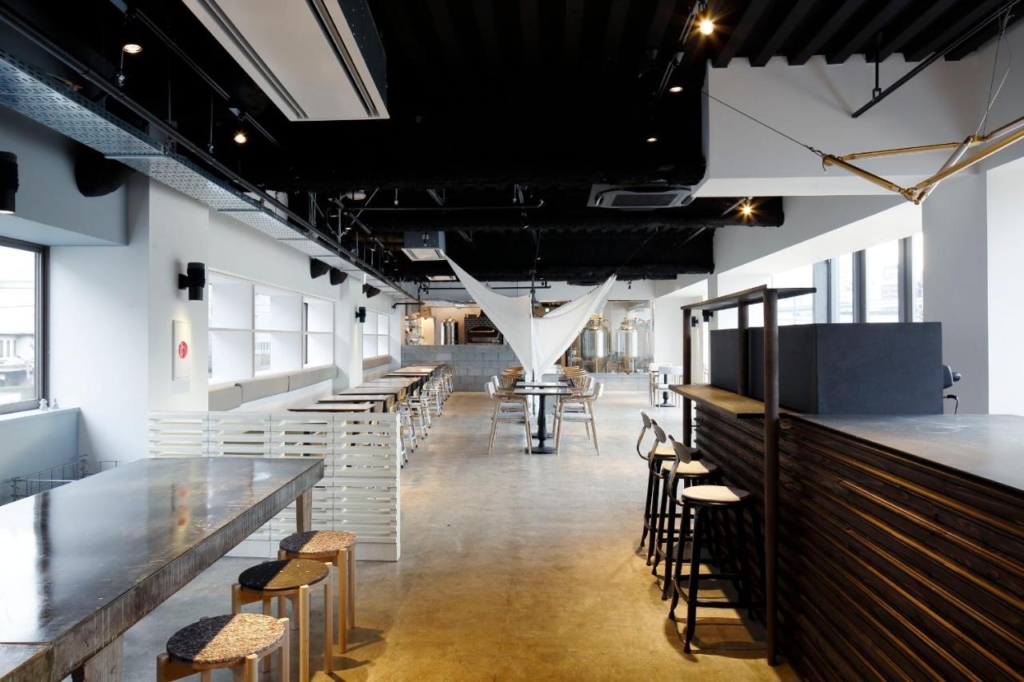
Boasting views of Tokyo Sky Tree from selected rooms, The Share Hotels Lyuro Tokyo Kiyosumi houses an on-site restaurant and bar. There is a large terrace overlooking the Sumida River. Tokyo Skytree is a 25-minute walk and train ride away, while Tokyo Disneyland is a 50-minute walk and train ride away. Guests can reach the lively Asakusa area with a 30-minute train ride.
Hotel JAL City Tokyo Toyosu (3 Stars)

Attractively set in Koto Ward, Hotel JAL City Tokyo Toyosu is situated 800 m from the Gas Science Museum, 1.4 km from Urban Dock LaLaport Toyosu, and 1.8 km from the i-muse IHI History Museum. Harumi Island Triton Square is 2.1 km from the hotel, while Hompo-ji Temple is 2.4 km away.
HOTEL LiVEMAX 豊洲駅前 (2 Stars)
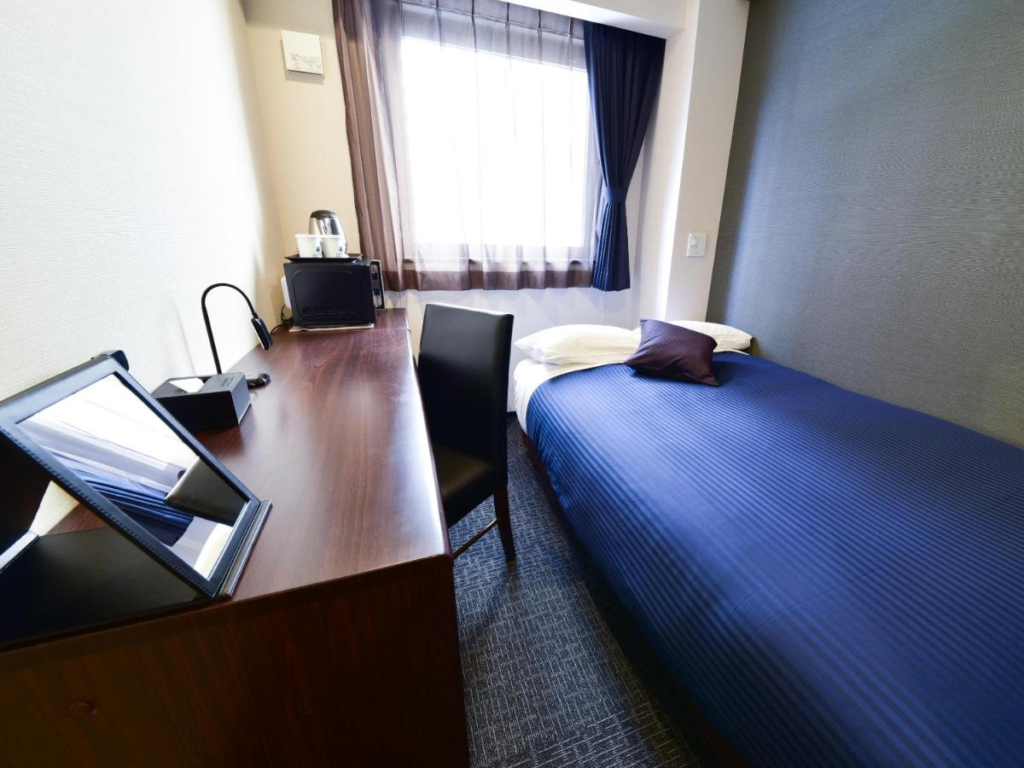
HOTEL LiVEMAX Toyosu Ekimae features air-conditioned rooms with flat-screen TVs in Koto Ward. Around 700 m from Urban Dock LaLaport Toyosu, the property is also 1 km away from the i-muse IHI History Museum. The Gas Science Museum is 1.6 km from the accommodation, while the Construction Technology History Exhibition Room is 1.8 km away.
R&B Hotel Tokyo Toyocho (3 Stars)

Situated in Koto Ward, R&B Hotel Tokyo Toyocho – Vacation STAY 40490v features accommodation with free WiFi throughout the property. The hotel is within 200 m of Susaki Stadium Monument and 300 m of Choshu Jade Cannon Founding Site. Other attractions nearby include Yokojikken-gawa Shinsui Park, Amagasaki River Green Road Park, and Toyosumi Park.
SARUE GUEST HOUSE in East Tokyo (2 Stars)

Set in Koto Ward, SARUE GUEST HOUSE in East Tokyo offers rooms with free WiFi. The guest house is located 500 m from Sarue Onshi Park and 700 m from The Centre of The Tokyo Raids and War Damage. Popular points of interest nearby include Heizo Hasegawa & Kinshiro Toyama Yashiki Monument, Ario Kitasuna Shopping Mall, and Bushumyoanzen-ji Temple Koto Batokanzenon. The property is 1.1 km from Oiteke Horiato Monument and 1.1 km from Sachio Ito Residence Monument.
Prime Suites Tokyo (3 Stars)

Prime Suites Tokyo features accommodation with free WiFi in Koto Ward, attractively set 90 m from Enmado Temple and 200 m from Basho Statue. The property is close to several well-known attractions, including the Shibusawa Eiichi Taku Monument, Honsei-ji Temple, and the Monument of The Birthplace of Cement Industry in Japan. The property is 600 m from Josho-in Temple and 600 m from Old Nitta Bridge. Popular points of interest near Prime Suites Tokyo include Inou Tadashi House Ruins, Wild Silk Museum, and Fukagawa Park.
Exploring Koto Ward
What do you think about Koto Ward in Tokyo? Do you enjoy discovering the history and culture of this fascinating area? Koto Ward is brimming with historical sites and unique activities, offering a blend of traditional charm and modern attractions. From the serene beauty of Kiyosumi Gardens to the vibrant energy of the Fukagawa Hachiman Festival, there is something for everyone to enjoy in this local neighbourhood.
If you’re planning a visit to Koto Ward, be sure to refer back to this blog for detailed information and tips. Whether you’re interested in the cultural heritage, scenic parks, or local festivals, this guide will help you make the most of your experience. Enjoy the rich tapestry of history and modernity that Koto Ward has to offer, and immerse yourself in its unique atmosphere.


Recent Comments